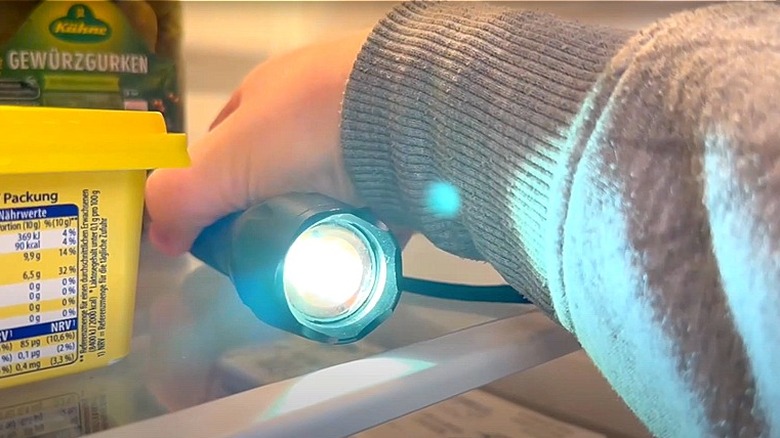How A Flashlight Can Check Your Refrigerator's Efficiency
Does this sound familiar? You open your refrigerator and notice your food isn't as cold as it should be. You may also notice your food is spoiling faster, ending up in the trash before its "use by" date. If this is the case, you should check your refrigerator's efficiency, which you can do with a simple hack that only takes a few minutes. All you have to do is place a flashlight inside your fridge and close the door.
When your refrigerator's door gasket (aka door seal) doesn't function as it should, cold air can seep out. Along with spoiled food, you may also notice a spike in your monthly energy bill — all because your fridge isn't running as efficiently as you thought. However, because the light inside your fridge shuts off when you close the door, it's hard to pinpoint what's going on; specifically, if the seal is working or not. The solution? Add a light on the inside of the refrigerator that will stay on even when the door closes and illuminate your fridge's problem.
All you need is a flashlight
This helpful hack quickly points to any issues with your refrigerator's gasket so you can correct the issue before more food goes to waste or before you run to purchase a new refrigerator for your kitchen. To do so, grab a flashlight — whatever you have available will do. Turn it on, place it in your refrigerator, and close the door.
Next, turn off all the lights in your kitchen. It might be easier to carry out this hack at night, unless you have a window treatment you can close shut. With the lights out and the refrigerator door closed, look to see if any light escapes from your flashlight and into the kitchen. If it does, it's time to replace your refrigerator door seal.
Don't stress if your refrigerator fails this efficiency test. You can easily purchase a new gasket online or at your local hardware store and replace it yourself. But you should perform this test whenever you suspect your refrigerator isn't performing as efficiently as it should, or annually as part of preventative appliance maintenance.

